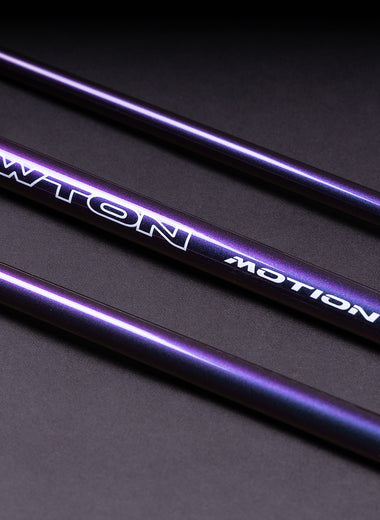Newton Motion Shaft Review
on
50 Words or Less
The Newton Motion shaft has a unique, fluid feel during the swing. Eschews weights and flexes for a simplified fitting system. Moderately priced and delivered ready to plug into your driver.

Introduction
Most successful companies want to expand. For putter makers, this typically means getting into wedges or accessories. Sacks Parente is not your typical putter company, so they turned their expertise making graphite shafts toward the opposite end of the bag: the driver.
The result is Newton Golf Shafts and their first release, the Newton Motion driver shaft. With two Champions Tour Top 3 Driving Accuracy performances already under its belt, it’s off to a prodigious start. I tested one to see if it can help regular golfers split more fairways, too.

Looks
The Newton Motion shaft makes a great first impression with a stunning, color-shifting paint job. A blend of blues, purples, and greens, the exact hues shift with the light. To me, it’s one of the best looking shafts in recent memory. I like even it more for its subdued tones which don’t scream for attention or cause distractions at address.

With such a bold color, the graphics don’t need to do much. The Newton branding is fairly basic and confined to the mid section of the shaft. You can get a blank look if you install the shaft logo down.
One final spot of interest is the array of dots below the Motion branding. Newton uses these dots to indicate the weight and flex of the shaft. This is a smart way to keep the loaded flex words – stiff, regular, senior – off the shaft.

Feel
The first thing I did after connecting the Newton Motion shaft to my PXG 0311 GEN6 driver [review HERE] was to give it the wiggle test. And wiggle it did. It seemed like I could see the shaft bending to and fro as I shook it, almost like a fly rod.
When I first took it to the range I was expecting this same sensation, and it delivered. The Newton Motion has a loose, languid feel that seems to encourage an unhurried swing. There isn’t a strong kick or release of energy nor a distinct bend point. It felt like it had more in common with swinging an Orange Whip than the types of shafts I typically game.
Interestingly, there was a noticeable change in feel when my speed ratcheted up or down. I tested the five dot model, which is recommended for speeds from 105-115 MPH. During that first session, I was right in the middle of that range. There were also sessions where I was at the bottom end of that range or even a bit below. At lower speeds, the shaft felt significantly more stable. It was still smooth, but the feel was more conventional.
If you want a smooth feel but don’t want to go too far from the norm, you might consider being a little ambitious with your choice of “flex.”

Performance
Newton touts four technologies in their Motion shaft. Elongated Bend Profile refers to the idea that the bend in the Motion happens over a longer span than with other shafts, leading to increased speed. Kinetic Storage Construction is the claim that through proprietary construction, the fibers in this shaft store more energy than in other shafts. The third technology is Newton Symmetry 360 Design, a claim that their shaft is spineless and free of inconsistencies. Finally, there’s Variable Bend Profile, the idea that each model is designed with matching bend and torque properties.
The latter two claims are not unique to Newton. Many companies such as TPT [review HERE] claim to produce spineless shafts. Similarly, other shaft makers vary their shafts within a given model to better fit the player.
Elongated Bend Profile, however, is something that I think most golfers will feel when swinging the Newton Motion shaft. Whether this truly stores more energy, I can’t say, but there is a unique feel to this shaft that does seem to promote a more relaxed swing. Whether or not that leads to superior results will vary.
For me, the Newton Motion was not a natural fit, but I was able to get good results after making some adjustments. Regular readers know that I am not a smooth or gentle swinger of the golf club. As such, my initial results ranged from “Left” to “Really Left.” These hooked shots came along with the matching lower launch and spin.
As I worked to smooth out my swing and actively keep the club face open, I began to produce picturesque push-draws. These shots launched high with mid-high spin and a moderate amount of draw. The threat of the hook was always in my mind, but the results of my focused swings were consistently strong.
The Newton Motion shaft is offered in six variants, denoted by the number of dots on the shaft. The lowest CPM, highest torque, lightest weight version has one dot. It specs out at 210 CPM, 45 grams, and 6.0 torque. The weight and CPM go up, and the torque goes down, as the number of dots increase. Newton’s six dot model weighs 70 grams, measures to 285 CPM, and has a 3.7 torque. According to Newton, the bend point of the shaft also moves up as the number of dots increases.

Conclusion
From the unique feel to the unusual fitting system, the Newton Motion shaft genuinely brings something different to the table. They’re also making aftermarket shafts more accessible with a direct to consumer price of $250 which includes a grip, the adapter of your choice, and 30 days to swap the shaft for a different “flex.” If you’re a smooth swinger looking for a shaft to complement your style, the Newton Motion is worth a look.
More from Plugged In Golf
More from Matt Saternus
View article on site HERE



